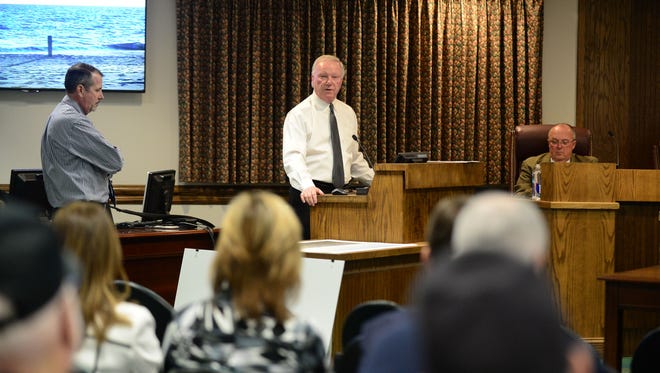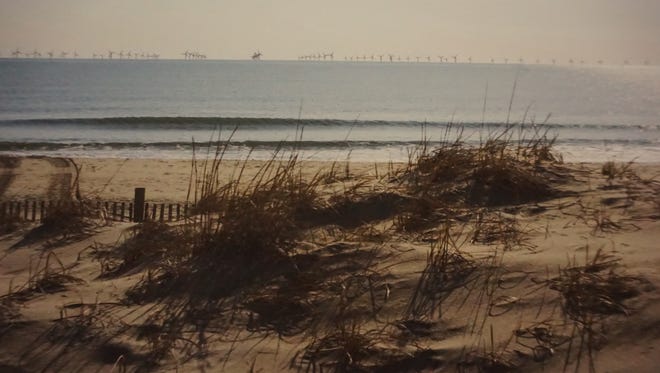Ocean City council votes to reject 'visible' offshore wind farm
 Jeremy Cox
Jeremy CoxOcean City’s town officials are turning up the heat on two offshore wind projects they say will spoil beach views and hurt the resort’s tourism industry.

The Town Council voted unanimously Monday night to oppose the construction of wind turbines that would be visible anywhere along the town’s 10 miles of coastline.
“This is a big project that will be there for many, many years, and we only get one chance to make it right,” Mayor Rick Meehan said. “Let’s not go build something we’re all going to regret.”
More:Local companies get funds to help build offshore wind industry, careers
The town's rejection is a political blow to America's first large-scale offshore wind development. But it is largely a symbolic one; the turbines are being planned in federal waters.
Meehan and several council members said they support the development of "green" energy and don't want a blanket ban on turbines built off Ocean City's shore. But the structures should be erected 26 miles away, where they won't be seen on the horizon, they said.
“We do want to be green. We do want to be good partners," Council President Lloyd Martin said. “Moving them out farther is not that an expensive thing to do. We’re only asking for 10 more miles beyond what they’re doing now.”
More:Offshore drilling: Hogan presses Interior Secretary Zinke to get Maryland exemption
U.S. Wind, Inc. is planning to initially build 32 turbines as close as 17 miles offshore. The company, a subsidiary of the Italian constructing firm Toto Holdings SpA, agreed last year to move the site back from 12 miles in response to Ocean City's concerns.
Meanwhile, Skipjack Offshore Energy LLC is looking to construct 15 turbines in an area just over 19 miles northeast of the coast of Maryland.
Neither company had representatives at the meeting. But Paul Rich, U.S. Wind's director of project development, said in an interview that the council's move was counterproductive toward reaching a compromise.
"They'd rather pass resolutions than meet with us," he said.
The Maryland Public Service commission gave U.S. Wind permission last year to build up to 187 turbines. Ocean City officials worry that future construction phases could ultimately bring the structures as close as 12 miles from shore.
Two large, flat-screen televisions at Monday's meeting showed renderings of what those turbines might look like at 99th Street. The images showed a solid line of steel forms against a blue sky along the horizon — relatively small and distant but clearly recognizable as wind turbines.

“We don’t want to have people walk out on the beach in the morning and look out at the sunrise over what would appear to be an industrial type of landscape," Meehan said.
And the view wouldn't get any better after sunset, Councilman John Gehrig said.
As a warning to air traffic, each turbine will be topped with a blinking red light. Those lights, he predicted, will resemble a "wall of Terminators walking in off the beach."
Riccardo Toto, U.S. Wind's president and CEO, questioned some of the assertions made by the town about the project.
In a statement released before the meeting, he said the generator at the center of the turbines' arms would stand 370 feet above the ocean surface, not 600 feet as the town suggested. (Town officials said they are measuring from the surface to the tip of an upright blade.)
And Toto disputed the allegation that they are "permanent" structures since a decommissioning bond is required for the removal of each.

Toto added that his company is working to address the town's concerns. For example, it is pursuing motion-detection nighttime lighting commonly used on European projects, he said.
All six present council members voted in favor of the resolution. Councilman Tony DeLuca was absent.
The hearing grew contentious after the vote when one member of the audience complained that the council acted without taking public comment. The Rev. Gregg Knepp, a senior pastor at St. Peter's Lutheran Church in Ocean City, protested the move from his seat.
As he did so, a town police office edged toward him, urging him to calm down. At one point, Knepp turned to the audience, asking, “Does anyone else feel like they’ve been flimflammed?"

Martin said comment would be allowed at the end of the meeting. After a tense moment or two, the officer guided Knepp out of the room with his hands. The pair conversed in measured tones for a few minutes in a hallway, and Knepp left shortly thereafter.
Later, during the public comment portion of the meeting, Crystal Hall of the Maryland chapter of the Sierra Club criticized the council for not letting people speak sooner.
“This has already happened and now we’re commenting after the fact," she said.
The council applied its meeting protocol correctly, Meehan said. Laws and ordinances require public comment before a vote but not resolutions like the one on the wind farms, he said.
410-845-4630
On Twitter @Jeremy_Cox